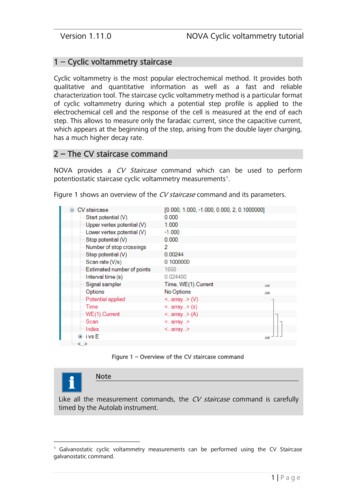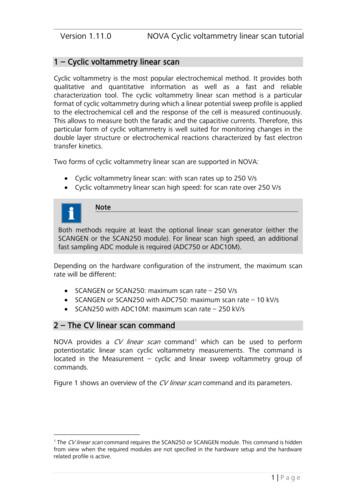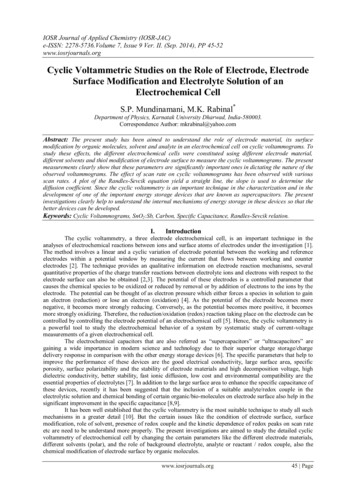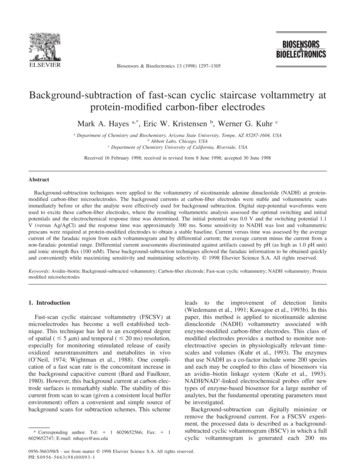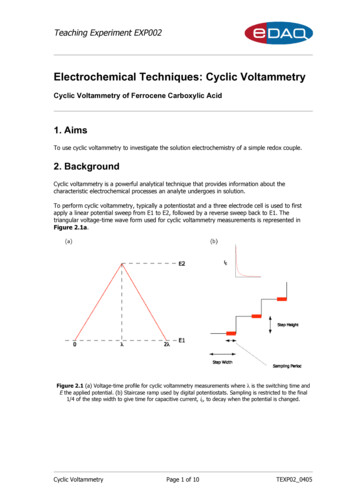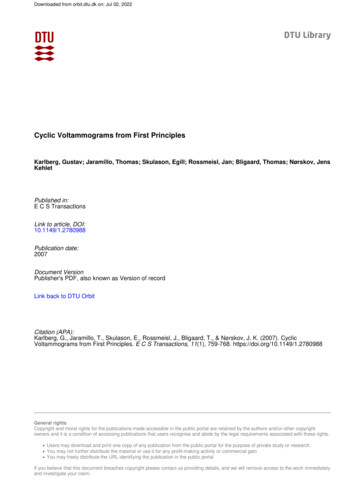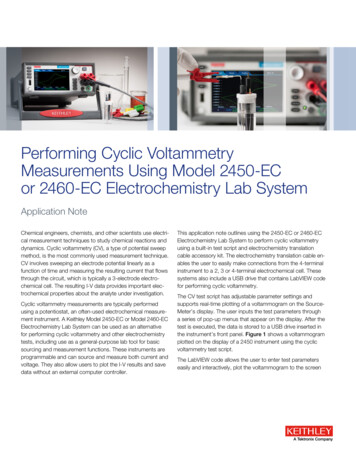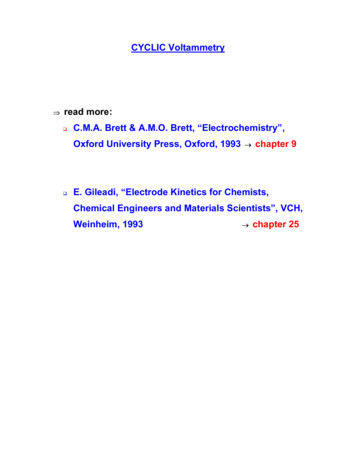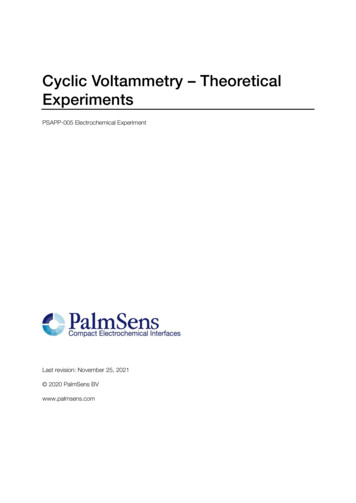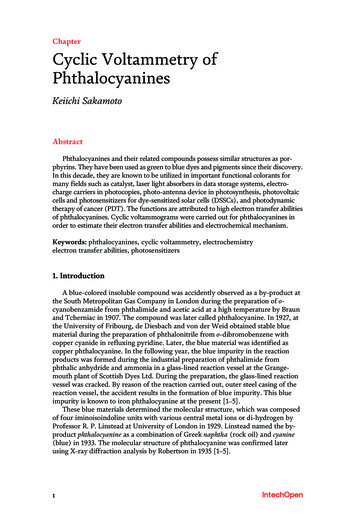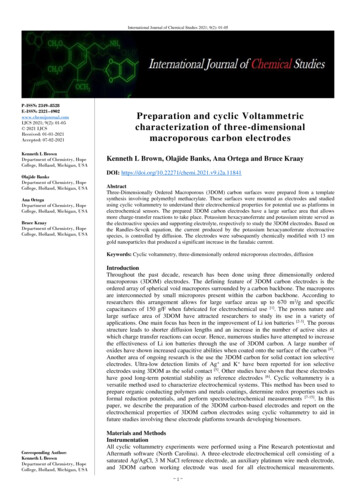
Transcription
International Journal of Chemical Studies 2021; 9(2): 01-05P-ISSN: 2349–8528E-ISSN: 2321–4902www.chemijournal.comIJCS 2021; 9(2): 01-05 2021 IJCSReceived: 01-01-2021Accepted: 07-02-2021Kenneth L BrownDepartment of Chemistry, HopeCollege, Holland, Michigan, USAOlajide BanksDepartment of Chemistry, HopeCollege, Holland, Michigan, USAAna OrtegaDepartment of Chemistry, HopeCollege, Holland, Michigan, USABruce KraayDepartment of Chemistry, HopeCollege, Holland, Michigan, USAPreparation and cyclic Voltammetriccharacterization of three-dimensionalmacroporous carbon electrodesKenneth L Brown, Olajide Banks, Ana Ortega and Bruce KraayDOI: stractThree-Dimensionally Ordered Macroporous (3DOM) carbon surfaces were prepared from a templatesynthesis involving polymethyl methacrylate. These surfaces were mounted as electrodes and studiedusing cyclic voltammetry to understand their electrochemical properties for potential use as platforms inelectrochemical sensors. The prepared 3DOM carbon electrodes have a large surface area that allowsmore charge-transfer reactions to take place. Potassium hexacyanoferrate and potassium nitrate served asthe electroactive species and supporting electrolyte, respectively to study the 3DOM electrodes. Based onthe Randles-Sevcik equation, the current produced by the potassium hexacyanoferrate electroactivespecies, is controlled by diffusion. The electrodes were subsequently chemically modified with 13 nmgold nanoparticles that produced a significant increase in the faradaic current.Keywords: Cyclic voltammetry, three-dimensionally ordered microporous electrodes, diffusionIntroductionThroughout the past decade, research has been done using three dimensionally orderedmacroporous (3DOM) electrodes. The defining feature of 3DOM carbon electrodes is theordered array of spherical void macropores surrounded by a carbon backbone. The macroporesare interconnected by small micropores present within the carbon backbone. According toresearchers this arrangement allows for large surface areas up to 670 m2/g and specificcapacitances of 150 g/F when fabricated for electrochemical use [1]. The porous nature andlarge surface area of 3DOM have attracted researchers to study its use in a variety ofapplications. One main focus has been in the improvement of Li ion batteries [2-3]. The porousstructure leads to shorter diffusion lengths and an increase in the number of active sites atwhich charge transfer reactions can occur. Hence, numerous studies have attempted to increasethe effectiveness of Li ion batteries through the use of 3DOM carbon. A large number ofoxides have shown increased capacitive abilities when coated onto the surface of the carbon [4].Another area of ongoing research is the use the 3DOM carbon for solid contact ion selectiveelectrodes. Ultra-low detection limits of Ag and K have been reported for ion selectiveelectrodes using 3DOM as the solid contact [5]. Other studies have shown that these electrodeshave good long-term potential stability as reference electrodes [6]. Cyclic voltammetry is aversatile method used to characterize electrochemical systems. This method has been used toprepare organic conducting polymers and metals coatings, determine redox properties such asformal reduction potentials, and perform spectroelectrochemical measurements [7-15]. In thispaper, we describe the preparation of the 3DOM carbon-based electrodes and report on theelectrochemical properties of 3DOM carbon electrodes using cyclic voltammetry to aid infuture studies involving these electrode platforms towards developing biosensors.Corresponding Author:Kenneth L BrownDepartment of Chemistry, HopeCollege, Holland, Michigan, USAMaterials and MethodsInstrumentationAll cyclic voltammetry experiments were performed using a Pine Research potentiostat andAftermath software (North Carolina). A three-electrode electrochemical cell consisting of asaturated Ag/AgCl, 3 M NaCl reference electrode, an auxiliary platinum wire mesh electrode,and 3DOM carbon working electrode was used for all electrochemical measurements. 1
International Journal of Chemical Studieshttp://www.chemijournal.comScanning electron microscope images of the 3DOM carbonsurfaces were obtained with a Hitachi TM3000 table topscanning electron microscope using an electron beam strengthof 15 kV.to age for 3 days at 85 ºC. Finally, the PMMA template,saturated with the resorcinol formaldehyde solution,underwent a carbonization process at 700 ºC in an inert argonatmosphere. The 3DOM electrodes were polished on a wetted600 grit sandpaper by applying a gentle pressure. This wasfollowed by sonicating the 3DOM carbon electroderepeatedly and rinsing the electrode until all traces of carbonpowder were removed. The electrodes were placed on top of avacuum filtration apparatus for 15 minutes, followed bydrying in an oven at 110 C for two hours. The dried 3DOMcarbon electrode was mounted to Ni mesh using a preparedglue solution containing 0.0150 g sodium carbonate and0.8250 g resorcinol in 1.13 mL formaldehyde. Sodiumbicarbonate was dissolved in formaldehyde after which theresorcinol was added and stirred for 20 minutes. The solutionwas heated to 40 C for 15 minutes and then the heat wasincreased to 55 C. The 3DOM electrode was placed in anoven at 110 C to harden the glue. Afterwards, the 3DOMcarbon electrode with the attached Ni mesh was sandwichedbetween two sheets of PVC such that all of the Ni mesh wascovered except for a small bit on the opposite end. Figure 1(a-c) shows an overview of the three-step construction of theelectrode.Electrochemical measurement parameters and solutionsThe electrolytic solution used for cyclic voltammetrymeasurements was 1.00 x 10-3 mol.L-1 K3Fe (CN)6 as theelectroactive species and 0.10 M KNO3 as the supportingelectrolyte. The solutions were prepared using water purifiedby reverse osmosis. Nitrogen gas was bubbled into thesolutions for at least five minutes before all electrochemicalexperiments and a nitrogen blanket was maintained over thesolution during the measurements. The potential window was1.00 V to -0.400 V with scan rates of 10-100 mV.s -1.3DOM electrode fabricationThe 3DOM platforms were prepared using colloidal crystaltemplating of polymethyl methacrylate (PMMA) spheres withno deviations from the literature procedures [21]. Aftersynthesizing the PMMA, the solution was left to dry for fortyfive days. Then, a resorcinol formaldehyde precursor solutionwas added to a small batch of dried PMMA template and leftFig 1: Preparation of electrode. Overview of the 3DOM electrode development process. a. 3DOM surface after carbonization from precursorsolution. b. Mounting of the electrode to the nickel wire mesh. c. 3DOM electrode covered with PVC sheetcarbon electrode when viewed with the naked eye. Suchopalescence arises due to the diffraction of light through theuniform distribution of the pores. The blue/green colorobserved is directly related to the size of the pores whereinthe pore size is on the same order as the wavelength of light.Scanning electron microscopy imaging shown in Figure 1reveals the porous nature of the 3DOM carbon electrode withan average pore size of 283 15 nm. This pore size agrees withpreviously reported colors and pore sizes [1]. Using EDS, therelative amount of gold, potassium, and sodium incorporatedinto the surface of the 3DOM electrode from the twonanoparticle immobilization methods was determined asshown in Table 1. For these three elements, the sonicationmethod yields lower amounts of gold, potassium and sodiumincorporated onto the 3DOM electrode surface. No doubt thesonication method results in the removal of the goldnanoparticles that were originally incorporated onto the3DOM electrode surface. Therefore, the drop-coating methodwas used to modify the 3DOM electrode surface for theelectrochemical studies discussed later.Gold nanoparticle treatment of the 3DOM carbonelectrodeGold nanoparticles were synthesized by a Frens citratereduction [17]. Aqua regia, followed by distilled water, wasused to rinse all glassware prior to use. Sodium citrate (38.8mM), in the amount of 25.00 mL was added to an aqueoussolution of potassium Tetrachloroaurate(III) dihydrate under astirred reflux. After which, the solution changed from paleyellow to dark red and was refluxed for an additional 15minutes. The solution was allowed to cool to roomtemperature prior to using them to modify the 3DOMelectrode. The surface of the 3DOM carbon electrode wasmodified by placing the 3DOM carbon in 20 mL of goldnanoparticle solution and sonicating for 1 hour, followed byplacing the electrode in the oven for one hour to dry. Anothermethod consisted of drop-coating the 3DOM electrode in thenanoparticle solution. The TM3000 along with BRUKERXFlash MIN SVE, BRUKER Scan Generator and Quantax 70software was used for elemental analysis via electron energydispersive X-ray spectrometry (EDS). A Cary 50 UV-Visibledouble-beam spectrometer (Varian) was used to obtain aspectrum of the gold nanoparticles.Table 1: Summary of gold nanoparticle immobilization. Elementalcomposition of 3DOM carbon surface after nano-particleimmobilization scheme. Two methods were used for immobilizationof nanoparticlesResults and DiscussionSEM characterization of the 3DOM carbon electrodeThe colloidal crystal templating of poly(methyl methacrylate)spheres facilitated the synthesis of 3DOM carbon electrode.The evenly distributed array of void spaces resulted in greenand blue colors being visible on the surface of the 3DOMElementGold (Au)Potassium (K)Sodium (Na) 2 Sonication139122229Drop-coating9847505824423
International Journal of Chemical Studieshttp://www.chemijournal.comFig 4: Overlay of various scan rates cyclic voltammograms from 10mV.s -1 to 100 mV.s -1. Solution consists of 1.00 x 10-3 mol.L-1K3Fe(CN)6 in 0.10 mol.L-1 KNO3. 3DOM working electrode,Ag/AgCl reference electrode, and platinum auxiliary electrode.Dimensions of the electrode were 3 mm x 2 mm x 1 mm (length xwidth x height)Fig 2: Scanning electron microscopy image of 3DOM carbon at30,000X magnification that shows the ordered array of sphericalvoid spaces present in the electrodeElectrochemical characterizationThe results from cyclic voltammetry measurements provideinsight into the performance of the 3DOM carbon as aworking electrode in three-electrode electrochemical cell.Figure 2 shows cyclic voltammograms at various scan ratesfrom 10 -100 mV.s-1. At a low scan rate of 10 mV.s-1, the peakseparation (ΔEp) is 0.089 V, but then increases to 0.180 Vwhen the scan rate increases to 100 mV.s-1; the ratio of thepeak currents (ipc/ipa) varies from 0.97 to 1.21. Both of theseparameters indicate that the electrochemistry of K3Fe(CN)6becomes more quasireversible using the 3DOM electrode.The formal reduction potential, Eo’, varies from 0.262 V to0.260 V and was determined using (Epa Epc)/2, where Epa andEpc are the anodic and cathodic peak potentials, respectively.A similar study reported on the diffusion of K 3Fe(CN)6 to anelectrode consisting of carbon nanotube bundles. Theyreported heavily overlapping diffusion layers at each carbonnanotube, which resulted in semi-infinite planar diffusionsimilar to diffusion at planar macroelectrodes [16].Fig 5: Diffusion controlled conditions graph. Graph showing therelationship between current and the square root of the scan rate atscan rates of 5 to 50 mV.s-1 with 1.00 x 10-3 mol.L-1 K3Fe(CN)6 using3DOM working electrode, Ag/AgCl reference electrode, andplatinum auxiliary electrode in 0.10 mol.L-1 KNO3In Figure 5, the equation of line reflective of the reductionprocess is y 0.0002x-9x10-5 and for oxidation process, theequation of the line is y -0.0002x-2 x10-5. Due to the porespresent within the 3DOM carbon electrode, diffusion of theelectroactive species resembles carbon nanotube bundleelectrodes. At each pore of the 3DOM electrode, overlappingdiffusion layers serve to channel electroactive species to theinner surfaces of the electrode. At higher scan rates (e.g., 100mV.s -1) only part of the electrode surface area is accessiblefor the Fe(III)/Fe(II) redox couple during the time scale of thecyclic voltammogram, and therefore diffusion of theelectroactive species to the inner pore surface area maybecome limited; with a large surface area confined within thepores, diffusion to the innermost parts of the pores may belimited and difficult to achieve. The relationship betweenFig 3: Scanning electron microscopy image of 3DOM carbon at250X magnificationPlots of the peak current relative to the square root of the scanrate produce linear trends as shown in Figure 4, indicatingdiffusion-controlled conditions as given by the RandlesSevcik equation (Eq. 1), where the symbols have their normalelectrochemical convention.ip 2.69 x 105n3/2AD1/2Cν1/2 (Eq. 1) 3
International Journal of Chemical Studieshttp://www.chemijournal.compeak separation and the scan rate indicates a quasireversiblesystem that is dependent upon the electron transfer kineticsbetween the Fe(III)/Fe(II) redox sites and the 3DOMelectrode surface. Both the peak separation and the ipc/ipavalues deviate from the idea values of 59 mV and 1.00,respectively for a reversible system. Figure 4 shows that theanodic and cathodic peak currents increase with higherconcentrations of K3Fe(CN)6, thus producing a trend thatfollows Eq. 1 over a range of 0 mol.L-1 to 0.100 mol.L-1; inFigure 4, scan rates of 2, 10, and 25 mV .s-1 were used. Thedifferent slopes of the lines reflect the various scan rates usedfor the reduction process, Fe3 e- Fe2 , wherein the slopescorresponding to 2, 10, and 25 mV .s-1 are 0.0283, 0.0638 and0.0970, respectively, and they reflect the square rootdependence on the scan rates.Fig 8: Cyclic voltammogram of 1.00 x 10-3 M K3Fe(CN)6 in 0.10 MKNO3 with a) 3DOM working electrode and b) 3DOM workingelectrode with immobilized gold nanoparticles. Both A and B:Ag/AgCl reference electrode, and platinum auxiliary electrode at 20mV.s -1Electrochemical impedance spectroscopy measurements weremade using frequencies 0.01-50000 Hz at 0.300 V to betterunderstand and differentiate the mass and charge transferprocesses at the 3DOM surfaces. The overall impedance ofthe 3DOM porous electrode is a composite of two processes:the charge transfer impedance of reactions within the poresand the mass transfer impedance within the pores. However,Figure 7 shows a Nyquist plot that has a negligible chargetransfer impedance. The diagonal line at low frequencies (i.e., 0.40 Hz) yields a phase angle of -45o for a Warburg masstransfer impedance.Fig 6 Current-Concentration profile. Graph showing the relationshipbetween current and concentration (0-0.10 mol.L-1) at scan rates of 2,10, and 25 mV.s-1 from 0 - 0.1 mol.L-1 K3Fe(CN)6 using 3DOMworking electrode, Ag/AgCl reference electrode, and platinumauxiliary electrode in KNO3.The surface of the 3DOM electrode was modified with goldnanoparticles (GN) using a drop-coating method. A UV-Visspectrum of the gold nanoparticles in Figure 7 shows a peakat 520 nm indicating the presence of the GN; the peak at 520nm is a result of the surface plasmon resonance. The presenceof the GN alters not only the surface area but also the surfaceenergy density of the 3DOM material. Immobilization of theGN onto the surface and within the pores of the 3DOMelectrodes yields a significant enhancement of the peakcurrents with more than a ten-fold increase as shown in Figure8. However, the peak separation increases by c.a. 0.200 Vwhen compared to electrodes with no immobilized goldnanoparticles.Fig 9: Electrochemical impedance spectrum. A nyquist plot show thewarburg impedance for a diffusion-based process using 1.00 x 10-3M K3Fe(CN)6 in 0.10 M KNO3 with 3DOM working electrode,Ag/AgCl reference electrode, and platinum auxiliary electrode at 10mV.s -1. The DC potential is 0.300 V with an AC component of0.010 V from 0.01- 50,000 HzOnly a fraction of the porous structure is accessible fordiffusion, and therefore, only a portion of the porous structureis available for capacitive double layer charging. The overallimpedance is dependent upon the geometry of the pores,penetration depth of the electroactive species and ions, andthe size distribution of n number of pores.ConclusionThe 3DOM electrode platforms were prepared using colloidalcrystal templating of polymethyl methacrylate (PMMA)Fig 7: Spectrum profile of gold nanoparticles. Spectrum from 350nm-700 nm in a 1-cm cuvette of gold nanoparticles showing anabsorbance maximum at 520 nm 4
International Journal of Chemical Studieshttp://www.chemijournal.comspheres. The electrochemistry of the electroactive species,K3Fe(CN)6, shows quasireversible behaviour using the 3DOMcarbon electrodes. One of the key features of these electrodesis the porous network distributed across the surface of theelectrode that facilitates the mass transport process ofdiffusion. Cyclic voltammetry measurements demonstratedthat currents produced in the three-electrode electrochemicalcell follow the Randles-Sevick equation, thus verifying adiffusion-controlled process; in addition, the peak currents areproportional to the concentration of the electroactive species.A significant increase in the faradaic current was observedduring cyclic voltammetric characterization when the goldnanoparticles were immobilized onto the 3DOM electrodesurface. These results show that the 3DOM electrode surfacescan be used in three-electrode electrochemical cell andchemically modified to alter the properties of the 3DOMelectrode surface. Further research is being conducted todetermine how these electrodes will perform in sensor andbiosensor applications.10.11.12.13.14.AcknowledgementsThis work was funded by the National Science Foundation:NSF-REU Grant #0851194 and NSF-URC Grant #0629174.15.References1. Lee KT, Lytle JC, Ergang NS, Oh SM, Stein A. Synthesisand rate performance of monolithic microporous carbonelectrodes for lithium-ion secondary batteries. Adv.Funct. Mater 2005;15(4):547-556.2. Vu A, Li X, Phillips J, Han A, Smyrl WH, Bühlmann P,Stein A. Three-dimensionally ordered ctrochemical double-layer capacitors with ionic liquidelectrolytes. Chem. Mater 2013;25(21):4137-4148.3. Hu YS, Adelhelm P, Smarsly BM, Hore S, Antonietti M,Maier J. Synthesis of hierarchically porous carbonmonolithic with highly ordered microstructure and theirapplication in rechargeable lithium batteries with highrate capability. Adv. Funct. Mater 2007;17(12):18731878.4. Wang Z, Li F, Ergang NS, Stein A. Chem. Mater. Effectsof hierarchical architecture on electronic and mechanicalproperties of nanocast monolithic porous carbon andcarbon-carbon nanocomposites 2006;18(23):5543-5553.5. Lai CZ, Joyer MM, Fierke MA, Petkovich ND, Stein A,Bühlmann P. Subnanomolar detection limit application ofion-selective electrodes with three-dimensionally orderedmicroporous (3DOM) carbon solid contacts. J Solid StateElectrochem 2009;13(1):123-128.6. Zhang T, Lai C-Z, Fierke MA, Stein A, Bühlmann P.Advantages and limitations of reference eletrodes with anionic liquid junction and three-dimensionally orderedmicroporous carbon as solid contact. Anal. Chem2012;84(18):7771-7778.7. Bettelheim A, White BA, Raybuck SA, Murray RW.Electrochemical Polymerization of Amino-, Pyrrole-, andHydroxy-SubstitutedTetraphenylporphyrins. Inorg.Chem 1987;26(7):1009-17.8. Dorman SC, Harrington JP, Martin MS, Johnson TV.Determination of the Formal Reduction Potential ofLumbricus Terrestris Hemoglobin Using Thin (1):185–88.9. Lindholm B. Ac-Impedance Studies of Charge Transportand Redox Capacities at Poly-4-Vinylpyridine Films on16.17. 5 Electrode Surfaces. J Electroanal. Chem. Inter.Electrochem 1990;289(1–2):85–101.Heinze J. Cyclic Voltammetry—‘ElectrochemicalSpectroscopy’. New Analytical Methods (25).Angewandte Chemie International Edition in English1984;23(11):831–47.Cinti S, Mazzaracchio V, Cacciotti I, Moscone D,Arduini F. Carbon Black-Modified Electrodes ScreenPrinted onto Paper Towel, Waxed Paper and ParafilmM . Sensors 2017;17(10):2267.Elgrishi N, Rountree KJ, McCarthy BD, Rountree ES,Eisenhart TT, Dempsey JL. A Practical Beginner’s Guideto Cyclic Voltammetry. J Chem. Educ 2018;95(2):197–206.D’Antonio EL, Bowden EF, Franzen S. Thin-LayerSpectroelectrochemistry of the Fe(III)/Fe(II) oanal. Chem 2012;668:37–43.Yu Y, Zhou M, Cui H. Synthesis andElectrochemiluminescence of Ruthenium(II)Functionalized Gold Nanoparticles. J Mater. Chem2011;21(34):12622–25.Brown KL, Danforth R, Bleitz E, Hwang Y, Rens D.Cyclic Voltammetric and Spectroelectrochemical Studiesof Tris(5-amino-1,10-Phenanthroline)Iron(II) PolymerFilms. Int. J Electrochem. Sci 2020;15:10707–10721.Fierke MA, Lai C, Buhlmann P, Stein A. Effects ofarchitecture and surface chemistry of three-dimensionallyordered macroporous carbon solid contacts onperformance of ion-selective electrodes. Anal. Chem2010;82:680-688.Frens G. Controlled nucleation for the regulation of theparticle size in mondisperse gold suspensions. Nat. Phys.Sci 1973;241:20-22.
Keywords: Cyclic voltammetry, three-dimensionally ordered microporous electrodes, diffusion Introduction The defining feature of 3DOM carbon electrodes is the ordered array of spherical void macropores surrounded by a carbon backbone. The macropores are interconnected by small micropores present within the carbon backbone.
